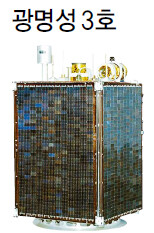hankyoreh
Links to other country sites 다른 나라 사이트 링크
North Korean satellite confirmed to be in orbit

By Kim Kyu-won, staff reporter
The second Kwangmyongsong-3 satellite, launched on Dec. 12 on North Korea’s Eunha-3 rocket, was confirmed to be orbiting Earth as of the following day.
But the South Korean Ministry of National Defense said it would take some time to determine if it is functioning properly and communicating back to North Korea.
Speaking at a Dec. 13 briefing, ministry spokesman Kim Min-seok confirmed that NORAD data showed the Kwangmyongsong-3 following an elliptical orbit around the Earth at a speed of 7.66 km/second, or 95.4 minutes per orbit.
“As to whether it’s functioning properly, we’re going to have to wait and see,” he added.
Kim went on to say that no communications with North Korea had yet come from the Kwangmyongsong-3.
“But we do anticipate some frequencies will emerge,” he added. “Under these conditions, we’ll view it as a success if it remains in orbit for about two weeks.”
After observing the figures, Korea Aerospace University professor Chang Young-keun concluded that the satellite did not achieve a precise 500km circular orbit.
“At its closest, it’s 494.85 km from Earth, at its farthest 588.13km,” Chang explained. “It’s supposed to correct to 500 km, and it looks like it doesn’t have the thruster to do that.”
North Korea’s state-run Korean Central News Agency reported on Dec. 12 that a signal was received at a command post indicating that the third stage rocket and satellite had separated.
“The ‘Song of General Kim Il-sung’ and ‘Song of General Kim Jong-il’ are currently ringing out from the second Kwangmyongsong-3 satellite,” the report said.
While no data were released for the satellite, experts believe it to be more or less identical to the first Kwangmyongsong-3, which crashed just after its April launch. North Korea announced that that satellite weighed 100kg and would pass in a sun-synchronous orbit at an altitude of 500km, with a lifespan of two years.
North Korea also said the satellite would be used to gather basic data for forest resource distribution, weather forecasting, and resource exploration.
Please direct questions or comments to [english@hani.co.kr]

Editorial・opinion
![[Column] Season 2 of special prosecutor probe may be coming to Korea soon [Column] Season 2 of special prosecutor probe may be coming to Korea soon](https://flexible.img.hani.co.kr/flexible/normal/500/300/imgdb/original/2024/0426/3317141030699447.jpg) [Column] Season 2 of special prosecutor probe may be coming to Korea soon
[Column] Season 2 of special prosecutor probe may be coming to Korea soon![[Column] Park Geun-hye déjà vu in Yoon Suk-yeol [Column] Park Geun-hye déjà vu in Yoon Suk-yeol](https://flexible.img.hani.co.kr/flexible/normal/500/300/imgdb/original/2024/0424/651713945113788.jpg) [Column] Park Geun-hye déjà vu in Yoon Suk-yeol
[Column] Park Geun-hye déjà vu in Yoon Suk-yeol- [Editorial] New weight of N. Korea’s nuclear threats makes dialogue all the more urgent
- [Guest essay] The real reason Korea’s new right wants to dub Rhee a founding father
- [Column] ‘Choson’: Is it time we start referring to N. Korea in its own terms?
- [Editorial] Japan’s rewriting of history with Korea has gone too far
- [Column] The president’s questionable capacity for dialogue
- [Column] Are chaebol firms just pizza pies for families to divvy up as they please?
- [Column] Has Korea, too, crossed the Rubicon on China?
- [Correspondent’s column] In Japan’s alliance with US, echoes of its past alliances with UK
Most viewed articles
- 1[Column] Season 2 of special prosecutor probe may be coming to Korea soon
- 2‘We must say no’: Seoul defense chief on Korean, USFK involvement in hypothetical Taiwan crisis
- 3N. Korean delegation’s trip to Iran shows how Pyongyang is leveraging ties with Moscow
- 4Amnesty notes ‘erosion’ of freedom of expression in Korea in annual human rights report
- 5[Editorial] Korea’s surprise Q1 growth requires objective assessment, not blind fanfare
- 6Division commander ordered troops to enter raging flood waters before Marine died, survivor says
- 7[Reportage] On US campuses, student risk arrest as they call for divestment from Israel
- 8Korea sees more deaths than births for 52nd consecutive month in February
- 9Is N. Korea threatening to test nukes in response to possible new US-led sanctions body?
- 10Is Japan about to snatch control of Line messenger from Korea’s Naver?